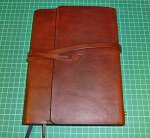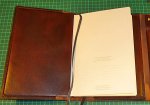N
Nomad
Guest
Been at the leatherwork again, this time a journal cover. It's made to suit an A5 notebook made by Leuchtturm...

When making a journal cover, it's important to take some care to ensure that the notebook can be replaced. It would be a bit of a waste of time to grab the current Moleskine-style knock-off from the supermarket, only to find that they've changed the range a year later, and that the one you designed around is no longer available. Pick a brand that's been around for a long time and keeps their products consistent. It's also worthwhile considering the paper. For example, Moleskines have a poor reputation for use with fountain pens (the ink often bleeds through to the other side). After some research, I went for a Leuchtturm 1917, both because they've been in the business since 1917, and because their notebooks seem to do quite well with fountain pens. The book also has a free-form contents page, each page is numbered (so the contents page is actually useful), and has two bookmark ribbons. They're also available in plain, lined, squared, and dotted. I went for plain and printed a bit of paper with heavy black lines that I can slip under the page I'm writing on. That way, my scrawl should stay horizontal, and I get blank pages for sketching on.
Anyway, on with the cover. There are a couple of Sam Browne studs at the side next to the flap...

They retain a leather tube thingy...

...which is my take on a pen holder...

While looking at journals for ideas, one thing I didn't like was the basic loop thing for holding the pen. They always seemed to be a bit insecure - the pen could either slip out, or the main part could separate from the cap. I wanted something that would keep the pen in place no matter what. The flat part of the holder is 2mm cow, and the tube part is 1mm goat, which is glued on at the edges and sewn at the closed end. Another Sam Browne for the closure (with the goat leather doubled over for better durability).
The cover is still quite stiff, but is gradually loosening up. The spine and the fold around the pen holder were wetted to encourage it to take the shape. It already lies quite flat when opened...

You can see that the Leuchtturm 1917 happily lies flat when opened.
Another thing I noticed on nearly all journal covers that I looked at was the retainers that go around the covers of the book - they only ever go part of the way across, meaning that writing only a few pages from the start and end, you get a bump. I assume the makers did this to save damaging the book when it was being inserted and removed. However, with a suitable construction of the right type of binding on the book, it should be possible to open the covers out until they're almost parallel. I found that the casebound Leuchtturm did this easily from new, so was able to make the cover retainer bits full width and avoid having the bump issue...

Same on both sides.
I'm really pleased with the result. By no means perfect, but pretty close to being exactly what I was looking for. The outer is 2mm cow, and the inner bits are 1mm goat. I did experiment with 2mm cow for the inners, but it was too thick - it was stressing the book. I might try a longer strap - the current one was an offcut from the main cover. If it doesn't retain well enough, it'll be easy enough to remove it and fit a longer one.
I don't actually keep a journal - I made this more to see if I could, and because nice journal covers have always looked appealing to me. Now that I have this, I may well write up the odd screed, probably as a sort of bushcraft diary. (I have no desire to write down my innermost thoughts, engage in one-sided gossip, or even record the events of the day should I happen to be visiting some strange Count in Transylvania to help with some legal matters. Oh dear, all my friends have been turned into vampires! I know! Rather than crapping myself and doing a runner, I'll write about it in my journal!)

When making a journal cover, it's important to take some care to ensure that the notebook can be replaced. It would be a bit of a waste of time to grab the current Moleskine-style knock-off from the supermarket, only to find that they've changed the range a year later, and that the one you designed around is no longer available. Pick a brand that's been around for a long time and keeps their products consistent. It's also worthwhile considering the paper. For example, Moleskines have a poor reputation for use with fountain pens (the ink often bleeds through to the other side). After some research, I went for a Leuchtturm 1917, both because they've been in the business since 1917, and because their notebooks seem to do quite well with fountain pens. The book also has a free-form contents page, each page is numbered (so the contents page is actually useful), and has two bookmark ribbons. They're also available in plain, lined, squared, and dotted. I went for plain and printed a bit of paper with heavy black lines that I can slip under the page I'm writing on. That way, my scrawl should stay horizontal, and I get blank pages for sketching on.
Anyway, on with the cover. There are a couple of Sam Browne studs at the side next to the flap...

They retain a leather tube thingy...
...which is my take on a pen holder...

While looking at journals for ideas, one thing I didn't like was the basic loop thing for holding the pen. They always seemed to be a bit insecure - the pen could either slip out, or the main part could separate from the cap. I wanted something that would keep the pen in place no matter what. The flat part of the holder is 2mm cow, and the tube part is 1mm goat, which is glued on at the edges and sewn at the closed end. Another Sam Browne for the closure (with the goat leather doubled over for better durability).
The cover is still quite stiff, but is gradually loosening up. The spine and the fold around the pen holder were wetted to encourage it to take the shape. It already lies quite flat when opened...

You can see that the Leuchtturm 1917 happily lies flat when opened.
Another thing I noticed on nearly all journal covers that I looked at was the retainers that go around the covers of the book - they only ever go part of the way across, meaning that writing only a few pages from the start and end, you get a bump. I assume the makers did this to save damaging the book when it was being inserted and removed. However, with a suitable construction of the right type of binding on the book, it should be possible to open the covers out until they're almost parallel. I found that the casebound Leuchtturm did this easily from new, so was able to make the cover retainer bits full width and avoid having the bump issue...

Same on both sides.
I'm really pleased with the result. By no means perfect, but pretty close to being exactly what I was looking for. The outer is 2mm cow, and the inner bits are 1mm goat. I did experiment with 2mm cow for the inners, but it was too thick - it was stressing the book. I might try a longer strap - the current one was an offcut from the main cover. If it doesn't retain well enough, it'll be easy enough to remove it and fit a longer one.
I don't actually keep a journal - I made this more to see if I could, and because nice journal covers have always looked appealing to me. Now that I have this, I may well write up the odd screed, probably as a sort of bushcraft diary. (I have no desire to write down my innermost thoughts, engage in one-sided gossip, or even record the events of the day should I happen to be visiting some strange Count in Transylvania to help with some legal matters. Oh dear, all my friends have been turned into vampires! I know! Rather than crapping myself and doing a runner, I'll write about it in my journal!)

